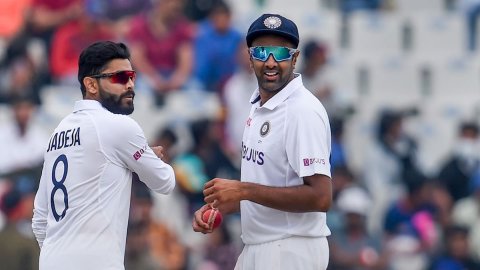Looming Sunset Of The ‘Ravis’?
For Team India, It is critical that before the first of the Ravis (Ashwin & Jadeja) walks into retirement, more spin options be found. Lest the departure of both Ravis create a huge sunset moment for India’s test bowling attack.

Earlier in 2024, on the first day of the test series against England, during the test match in Hyderabad, the spin duo of Ravichandran Ashwin and Ravindra Jadeja crossed a significant joint milestone. They passed Anil Kumble and Harbhajan Singh’s record of 501 wickets in 54 test matches together, and they did this feat in 50 tests, four fewer than the legendary duo.
While lauding this tremendous achievement of the pair, perhaps the time has come to ponder the concern that this feat also implies. When Kumble and Harbhajan were both around, usually only one of them played tests in SENA countries at a time, given the nature of the pitches. At home, when both played in the XI, they sometimes had a third spinner – a Murali Karthik, for instance. And in that era, there were change bowlers who could also pose a threat to the best of batsmen – Tendulkar, for one. Even Sehwag, Yuvraj and later, Suresh Raina, could roll their arm over for on occasion, pick up a wicket.
Trending
Importantly, this was the time that India saw a surge in pace bowling stocks - the attack leader was Zaheer Khan, supported by Sreesanth, RP Singh, Ishant Sharma and Munaf Patel etc. Irfan Pathan was still in contention, as was Ashish Nehra. Somewhere on the horizon were promising names such as VRV Singh, Umesh Yadav and a very quick Varun Aaron. Spin, therefore, was important, but clearly the thrust was on pace.
Post the Kumble era, off-spinning Harbhajan became the lead spinner. Pragyan Ojha gradually made his presence felt and secured a spot in the team, at least for home tests on slow, turning tracks. However, on the tour of England in 2011, it became apparent that Harbhajan was in decline. His returns on that tour were a paltry two wickets in two tests. The team was clearly in transition and young spinners were needed.
It was in this scenario that Ashwin came into the team, in 2011, and made an immediate impact, taking nine wickets and the man of the match award in his debut test (versus West Indies, Delhi, 2011). His spin partner was Ojha, who took seven in the match. The writing was on the wall. Ashwin had arrived and he would, in effect, replace the ageing Harbhajan. The latter would hang on in test cricket for nearly four years more, taking just eleven wickets in five tests. Bhajji would bow out with a stunning 417 wickets in 103 tests, at age 35. But even before he was done, Ojha’s test career ended prematurely – the (under)stated reason was that his action was suspect. Interestingly, Ojha took a ten wicket haul (and the man of the match award) in his very last test, which happened to be Tendulkar’s farewell match too. Ojha would not be missed!
A year prior, the selectors had blooded another young player in the team. Ravindrasinh Anirudhsinh Jadeja made his debut against England in Nagpur in late 2012. He came in as a left arm spinner with known batting capability, having made some daddy hundreds at the domestic level. From his second test series, at home against Australia in early 2013, he began making a significant impact as a left arm spinner. Over the next decade, the two Ravis – Ashwin and Jadeja – would make an immense contribution to the team. The Kumble-Harbhajan pattern was repeated in many ways, with usually only one of the two in the playing XI in tests abroad. In the Kohli era, pace remained the key especially abroad, with Bhubaneswar-Bumrah-Shami and others doing the damage, while a spinner did a holding job. At home, it was spin all the way, with pace bowlers making key breakthroughs.
But now, more than halfway through 2024, Ashwin and Jadeja are exactly where Harbhajan was in 2011-12, on the decline. Ashwin hasn’t been in the T20 squad for a while and Jadeja too has quit the shortest form. Their last ODI was in the World Cup in 2023, their last test match being the one against England in Dharamshala early this year. Ashwin is two months shy of his 38th birthday, Jadeja is close to 36 years of age. The end is nigh and it is only a matter of time, or of a single bad series that one or both these legends walk away into the sunset! Does India have a plan to replace them, like the selectors found Ashwin before Harbhajan was done?
Not only will these two stalwarts be missed for their bowling, but for their prowess as all-rounders. With these two in the side, the team management got away with playing five specialist batsmen in tests within India, sometimes even abroad. In SENA countries, it allowed skippers like Kohli to play just five batsmen, as well as four seamers. The statistics of the two Ravis are stunning by themselves:
R Ashwin: 100 tests – 516 wickets with five wickets in an innings 36 times and 10 wickets in a match 8 times. 3309 test runs with 5 hundreds and 14 half centuries.
R Jadeja: 72 tests – 294 wickets with five wickets in an innings 13 times and 10 wickets in a match 2 times. 3036 test runs with 4 hundreds and 20 half centuries.
